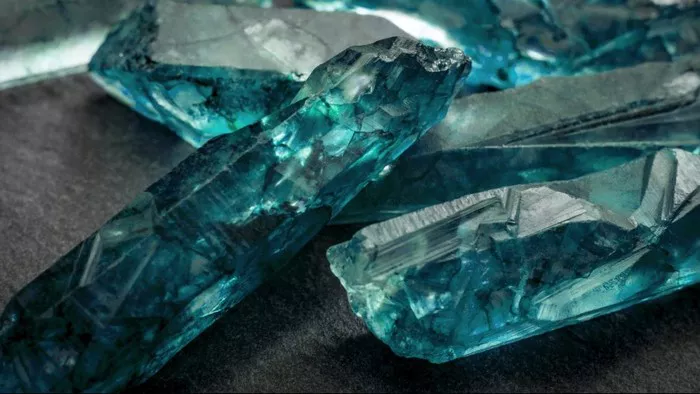Aquamarine is a mesmerizing gemstone prized for its serene blue hues, clarity, and elegance. While most people are familiar with the polished and faceted aquamarines commonly seen in jewelry, raw aquamarine specimens have their own unique charm and allure. In this article, we’ll explore the value of raw aquamarine, what influences its price, and why it is treasured by gemstone enthusiasts and collectors.
Introduction to Raw Aquamarine
Raw aquamarine, also known as rough aquamarine or uncut aquamarine, refers to aquamarine crystals in their natural, unprocessed state. Unlike polished gemstones, raw aquamarine retains its natural shape, texture, and crystal formations, showcasing the raw beauty of the gemstone. Raw aquamarine is typically extracted from the earth through mining processes and is then cleaned, sorted, and sometimes cut and polished into finished gemstones.
Aquamarine is a member of the beryl mineral family, which also includes other gemstones such as emerald, morganite, and heliodor. The name “aquamarine” is derived from the Latin words “aqua” and “marina,” meaning “water of the sea,” reflecting the gemstone’s tranquil blue color reminiscent of the ocean. Aquamarine’s color is due to trace amounts of iron within the crystal structure, which can range from pale, icy blues to deep, vibrant hues.
Factors Affecting the Value of Raw Aquamarine
Several factors influence the value of raw aquamarine, including the following:
Color: The color of aquamarine is the most important factor in determining its value. The most desirable aquamarines exhibit a pure, vibrant blue color with excellent clarity and transparency. Stones with a rich, saturated blue hue are highly prized and often command premium prices in the market. Aquamarines with greenish or grayish undertones may be less valuable than those with a true blue color.
Clarity: Clarity refers to the presence of internal characteristics, known as inclusions, within the aquamarine. While some inclusions are acceptable and may even add to the gemstone’s character, high-quality aquamarines exhibit excellent clarity and transparency. Eye-clean stones with minimal visible inclusions are more valuable than heavily included specimens.
Size: The size of a raw aquamarine crystal can significantly affect its value. Larger crystals are rarer and thus more valuable than smaller ones. However, the price per carat tends to increase exponentially as the size of the aquamarine increases, meaning that larger crystals can be significantly more expensive on a per-carat basis.
Transparency: Raw aquamarines can vary in transparency from opaque to semi-transparent. Some specimens may have a cloudy or milky appearance due to the presence of internal inclusions or fractures, while others may exhibit greater clarity and transparency, allowing light to pass through the gemstone.
Shape and Formation: The natural shape and formation of a raw aquamarine crystal can also influence its value. Well-formed crystals with sharp edges and defined crystal faces are more desirable than irregular or distorted shapes. Aquamarine crystals with unique formations or crystal habits may also be prized by collectors for their beauty and rarity.
How Much Is Raw Aquamarine Worth?
The value of raw aquamarine can vary widely depending on factors such as color, clarity, size, transparency, and crystal formation. In general, raw aquamarine is less expensive than polished and faceted aquamarine gemstones, as the latter require additional processing and cutting to achieve their final appearance.
At the lower end of the price spectrum, small to medium-sized raw aquamarine crystals with lighter or less saturated colors and visible inclusions may be relatively affordable and accessible. These specimens are often used by lapidaries and jewelry designers to create unique, one-of-a-kind pieces of jewelry and decorative objects.
On the other hand, rare and exceptional raw aquamarine crystals with intense, saturated blue colors, excellent clarity, and large crystal sizes can command premium prices in the market. These specimens are highly sought after by collectors and connoisseurs for their beauty, rarity, and investment potential. In particular, large, museum-quality aquamarine crystals with exceptional color and clarity can fetch prices comparable to those of top-quality gemstones such as diamonds and emeralds.
Conclusion
In conclusion, raw aquamarine is a natural, unprocessed gemstone prized for its serene blue hues, clarity, and elegance. The value of raw aquamarine depends on factors such as color, clarity, size, transparency, and crystal formation, with rare and exceptional specimens commanding premium prices in the market. Whether you’re a gemstone enthusiast, collector, or jewelry designer, raw aquamarine offers a unique and captivating option for incorporating the beauty of nature into your designs. With its tranquil color, timeless appeal, and natural allure, raw aquamarine continues to captivate and inspire people around the world.


